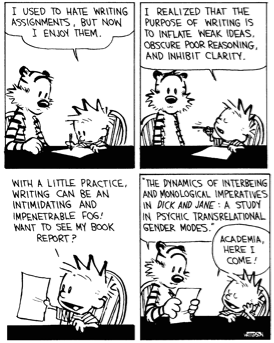
Writing



So, four points that almost everyone could stand to review before writing the next paper.
1. Although these short papers are somewhat informal (no citations needed, no extended analysis required), they still need to present an argument. An argument is a complex claim that is not obvious. It is marked by sentences like: “In what follows, I will argue that Fellini’s sexism, although typical of his time, was more than just sexism. Despite his male characters’ protestations of love for women, they are two-dimensional sexual objects at best, and examples of the abject, the “less than human” at their worst.”
2. Contrast this to a mere observation: “Fellini is sexist.” That may be true, but it is a claim that is unproblematized, simple; it has no frame that explains why this observation should particularly matter. The “frame” acknowledges that the issue is complex: Fellini was sexist, but wasn’t that pretty typical for an Italian man who grew up in the 1930s? And don’t his characters love women? It was and they do, so we need to make it clear than the argument goes beyond—it is something more than the ordinary, something more than we expect, and it expresses the attitude of the writer towards the subject (anti-Fellini, in this case).
3. Almost all of the papers stayed at the very general level of what characters say and do—what happens in the films. That’s a necessary step, but a first one. Everyone should make use of the “film terms” above to start to see how the visual and auditory construction of the film intensifies (or works against) the argument you are making. When you refer to details like costuming, lighting, props, camera movement, colors, soundtrack, and so on, you sound like you have not only seen the films, but like you’ve really watched them. Your argument has not only breadth, but also depth. You don’t have to fill your paper up with such details. You might say: “Fellini’s misogyny can be seen both at the largest and smallest levels, from the recurring half-woman, half-beast (Saraghina, Volpina) to Guido’s mistress’ clothes—expensive but in poor taste, ostentatious and ridiculous.”
4. All film titles should be italicized or underlined (preferably italicized). In English, all words are capitalized other than prepositions (for, in, by, along) and non-initial articles (the, a, an) (The Big Sleep, Bridge on the River Kwai). In Italian, only the first word and subsequent proper nouns are capitalized (La presa di Roma, Le notti di Cabiria, Lo sceicco bianco). (In French, if the first word is an article, then the second word is also capitalized: Les Quatre cents coups, but Hiroshima mon amour).